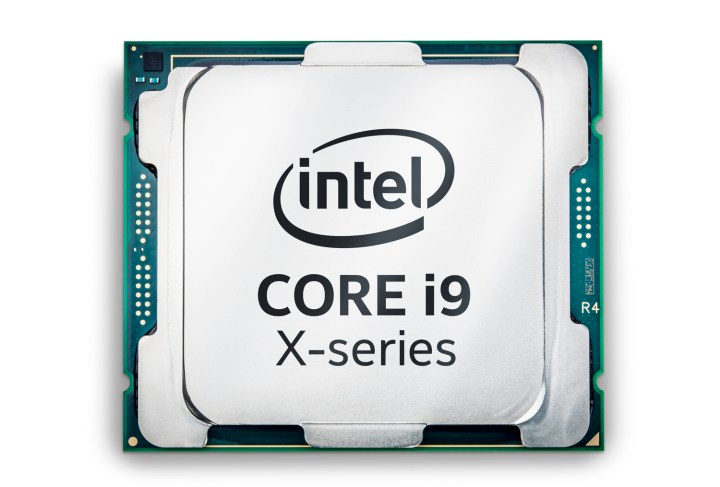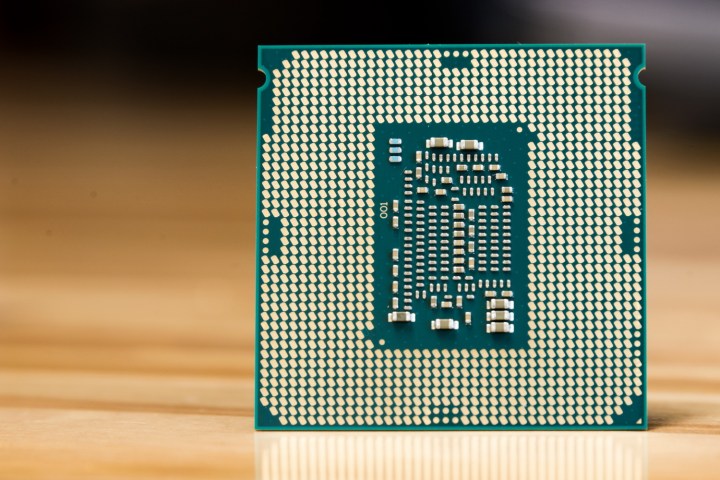
Intel’s current crop of X-Series processors contains 12 models dating back to the third quarter of 2014. Another Core i9 model is slated to arrive on August 28, followed by three more Core i9 chips on September 25.
The motherboard manufacturers supporting these chips haven’t held back. Gigabyte has around 26 models, the biggest third-party X Series component supplier we’ve seen thus far. So, to make building an X Series desktop easy, we’ve thrown all the Intel X Series news and information we could find in a single post.

Big seats for big performance
Currently, the Core X-Series desktop processor family relies on two different motherboard “seats,” or sockets, created by Intel. The LGA 2066 socket is the latest version to accommodate the seventh-generation chips, and replaces the LGA 2011-v3 motherboard seat used by Intel’s sixth and fifth-generation X-Series processors. As a brief explanation, LGA is short for land grid array, which describes the grid of contacts located on the belly of an Intel processor. The socket’s number corresponds to the number of contacts on the actual CPU.
That said, these two processor seats are used by specific processors based on specific CPU designs, and are compatible with specific motherboard chipsets created by Intel. The newer LGA 2066 socket supports the seventh-generation Intel Core i5-7640X chip to the upcoming Core i9-7980XE, and the X299 motherboard chipset. The LGA 2011-v3 socket supports the fifth-generation i7-5820K to the sixth-generation i7-6950X, and the X99 motherboard chipset.
Here’s an easier way to see the X-Series landscape:
| Processors | Generation | Socket | Chipset |
| i5-7640X to i9-7980XE |
7 | LGA 2066 | X299 |
| i7-6800K to i7-6950X |
6 | LGA 2011-v3 | X99 |
| i7-5820K to i7-5960X |
5 | LGA 2011-v3 | X99 |
Notice in the chart that the processor number corresponds with its generational design. For example, the first number after the hyphen for the i7-5820K is “5,” which means it’s a fifth-generation chip. All generational processor designs have code-names too, with the fifth generation code-named “Broadwell,” the sixth generation named “Skylake,” and the seventh generation named “Kaby Lake.”

A confusing family tree
But Intel will take a generational chip design, revamp it for better processing and added features, and launch products alongside the current-generation portfolio. Thus, you’ll find new X-Series processors released this year that are based on last-year’s chip design, only enhanced and now considered as a current-generation solution.
For instance, Intel launched its “Skylake” sixth-generation processor family in August of 2015. But Intel’s seven new X-Series chips ranging from the i7-7800X to the i9-7980XE are based on an enhanced version code-named “Skylake-X” that provides extra internal work space for the chip to use during its calculations, and the largest core count thus far. This processor design also increases the number of supported PCI Express 3.0 lanes to 44, supports quad-channel DDR4 memory up to 2,666MHz, and disables the integrated graphics.
Next are two X-Series chips that are based on Intel’s “Kaby Lake-X” architecture, the i5-7640X and the i7-7740X. This enhancement to the current processor design disables the integrated graphics, and increases the chip’s total power draw so it can receive extra voltage for higher speeds. And like the Skylake-X models, these processors are unlocked, enabling users to push the chips beyond their out-of-the-box limits.
Further down the X-Series totem pole are four sixth-generation processors based on a revised fifth-generation design called “Broadwell.” The revision is dubbed as “Broadwell-E,” and introduced support for mainstream enthusiast processors with ten cores. The original Broadwell design is actually a smaller version of Intel’s previous fouth-generation processor design called “Haswell.”
To make matters even more confusing, Intel redesigned the original Haswell architecture and dubbed it as “Haswell-E” for its fifth-generation processor lineup. This design increased the supported core count to eight for the enthusiast mainstream processor market. Intel sells three X-Series desktop processors based on the Haswell-E architecture.
If all of this code-name and generational talk is a little confusing, perhaps this chart will provide a better visual reference for all the lakes and wells in play:
| Generation 7 | Generation 6 | Generation 5 | Generation 4 |
| Skylake-X (Q2/Q4 2017) Kaby Lake-X (Q2 2017) Kaby Lake (Q1 2017) |
Broadwell-E (Q2 2016) Skylake (Q3 2015) |
Broadwell (Q1 2015) Haswell-E (Q3 2014) |
Haswell (Q2 2013) |
Intel Core X-Series’ current line-up
Lastly, here are the actual X-Series processors, their prices, speeds, and launch dates. Keep in mind that the four chips arriving in late August and September don Intel’s new Core i9 branding, and follow the first Core i9-branded chip released in the second quarter of 2017. The current Core i9 chip hits the $1,000 barrier, while the 18-core i9-7980XE monster will cost the enthusiast crowd twice that amount.
Remember: this is just for a single processor. Adding all the other components like the case, motherboard, graphics card, and whatnot are in addition to those four-digit price tags. Eventually all of the new technology will trickle down into the mainstream markets, such as having more than four cores, and more than two speeds. But for the latest processor technology from Intel, you’re going to shell out bags of cash.
| Generation/ Architecture |
Cores/ Threads |
Base Speed | Turbo Speed | Max Speed | Available | Price | |
| i9-7980XE | 7 Skylake-X |
18 / 36 | 2.60GHz | 4.20GHz | 4.40GHz | Sept. 25 | $1,999 |
| i9-7960X | 7 Skylake-X |
16 / 32 | 2.8GHz | 4.20GHz | 4.40GHz | Sept. 25 | $1,699 |
| i9-7940X | 7 Skylake-X |
14 / 28 | 3.10GHz | 4.30GHz | 4.40GHz | Sept. 25 | $1,399 |
| i9-7920X | 7 Skylake-X |
12 / 24 | 2.90GHz | 4.30GHz | 4.40GHz | August 28 | $1,199 |
| i9-7900X | 7 Skylake-X |
10 / 20 | 3.30GHz | 4.30GHz | 4.50GHz | Q2 2017 | $999 |
| i7-7820X | 7 Skylake-X |
8 / 16 | 3.60GHz | 4.30GHz | 4.50GHz | Q2 2017 | $599 |
| i7-7800X | 7 Skylake-X |
6 / 12 | 3.50GHz | 4.00GHz | N/A | Q2 2017 | $389 |
| i7-7740X | 7 Kaby Lake-X |
4 / 8 | 4.30GHz | 4.50GHz | N/A | Q2 2017 | $339 |
| i5-7640X | 7 Kaby Lake-X |
4 / 4 | 4.00GHz | 4.20GHz | N/A | Q2 2017 | $242 |
| i7-6950X | 6 Broadwell-E |
10 / 20 | 3.00GHz | 3.50GHz | N/A | Q2 2016 | $1,399 |
| i7-6900K | 6 Broadwell-E |
8 / 16 | 3.20GHz | 3.70GHz | N/A | Q2 2016 | $889 |
| i7-6850K | 6 Broadwell-E |
8 / 16 | 3.60GHz | 3.80GHz | N/A | Q2 2016 | $359 |
| i7-6800K | 6 Broadwell-E |
6 / 12 | 3.40GHz | 3.60GHz | N/A | Q2 2016 | $319 |
| i7-5960X | 5 Haswell-E |
8 / 16 | 3.00GHz | 3.50GHz | N/A | Q3 2014 | $1,072 |
| i7-5930K | 5 Haswell-E |
6 / 12 | 3.50GHz | 3.70GHz | N/A | Q3 2014 | $480 |
| i7-5820K | 5 Haswell-E |
6 / 12 | 3.30GHz | 3.60GHz | N/A | Q3 2014 | $374 |
What’s next for the X-Series?
Once the last four X-Series processors based on the Skylake-X design hit the market, Intel will mainly focus on getting its eighth-generation processors to the market based on its “Coffee Lake” design. Yes, we are well aware of all the lakes flowing out of Intel. Even more, the next X-Series chips will likely be based on Kaby Lake-X and Coffee Lake-X in the second half of 2018, staying true to Intel’s liquid code names.
That said, keep checking back for more Intel Extreme Edition news right here as all related products hit the street.


